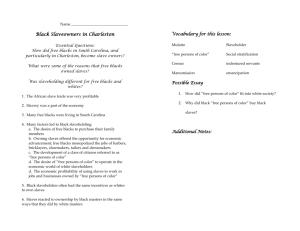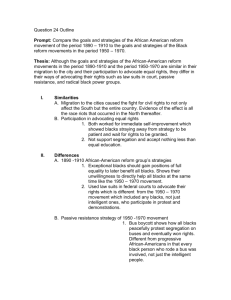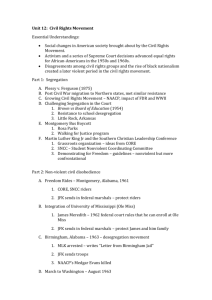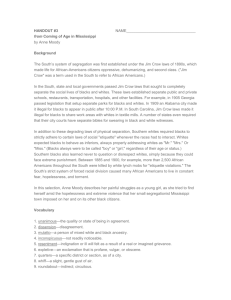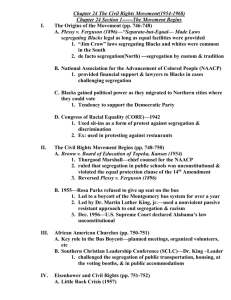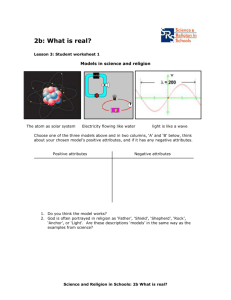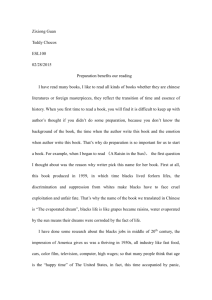The Civil Rights Era (1865–1970)
advertisement
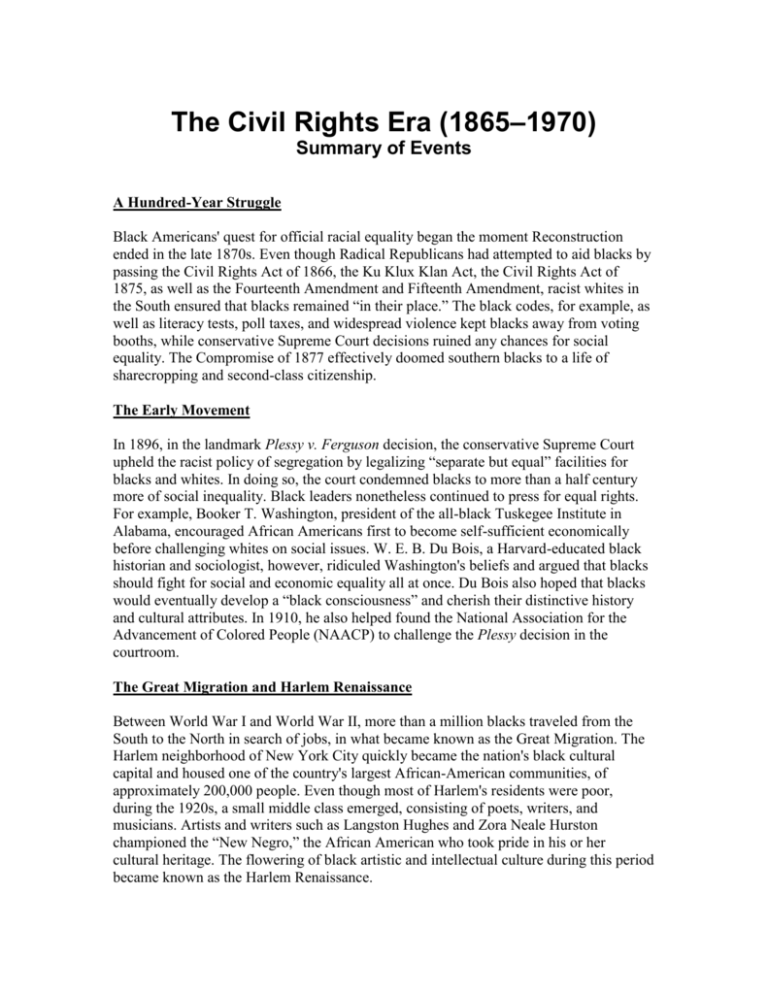
The Civil Rights Era (1865–1970) Summary of Events A Hundred-Year Struggle Black Americans' quest for official racial equality began the moment Reconstruction ended in the late 1870s. Even though Radical Republicans had attempted to aid blacks by passing the Civil Rights Act of 1866, the Ku Klux Klan Act, the Civil Rights Act of 1875, as well as the Fourteenth Amendment and Fifteenth Amendment, racist whites in the South ensured that blacks remained “in their place.” The black codes, for example, as well as literacy tests, poll taxes, and widespread violence kept blacks away from voting booths, while conservative Supreme Court decisions ruined any chances for social equality. The Compromise of 1877 effectively doomed southern blacks to a life of sharecropping and second-class citizenship. The Early Movement In 1896, in the landmark Plessy v. Ferguson decision, the conservative Supreme Court upheld the racist policy of segregation by legalizing “separate but equal” facilities for blacks and whites. In doing so, the court condemned blacks to more than a half century more of social inequality. Black leaders nonetheless continued to press for equal rights. For example, Booker T. Washington, president of the all-black Tuskegee Institute in Alabama, encouraged African Americans first to become self-sufficient economically before challenging whites on social issues. W. E. B. Du Bois, a Harvard-educated black historian and sociologist, however, ridiculed Washington's beliefs and argued that blacks should fight for social and economic equality all at once. Du Bois also hoped that blacks would eventually develop a “black consciousness” and cherish their distinctive history and cultural attributes. In 1910, he also helped found the National Association for the Advancement of Colored People (NAACP) to challenge the Plessy decision in the courtroom. The Great Migration and Harlem Renaissance Between World War I and World War II, more than a million blacks traveled from the South to the North in search of jobs, in what became known as the Great Migration. The Harlem neighborhood of New York City quickly became the nation's black cultural capital and housed one of the country's largest African-American communities, of approximately 200,000 people. Even though most of Harlem's residents were poor, during the 1920s, a small middle class emerged, consisting of poets, writers, and musicians. Artists and writers such as Langston Hughes and Zora Neale Hurston championed the “New Negro,” the African American who took pride in his or her cultural heritage. The flowering of black artistic and intellectual culture during this period became known as the Harlem Renaissance. Marcus Garvey Meanwhile, Marcus Garvey, a Jamaican immigrant and businessman, worked hard to promote black pride and nationalism. He founded the Universal Negro Improvement Association, which emphasized economic self-sufficiency as a means to overcome white dominance. He also encouraged blacks to leave the United States and resettle in Africa. Although most of Garvey's business ventures failed and he was eventually deported back to Jamaica, his message influenced many future civil rights leaders. World War II More than a million black men served in the Allied forces during World War II, mostly in segregated noncombat units. At home, black leaders continued to push for racial equality and campaigned for the “Double V”—victory both at home and abroad. In 1941, A. Philip Randolph, the president of the National Negro Congress, threatened to lead thousands of black protesters in a march on Washington to demand the passage of more civil rights legislation. President Franklin Delano Roosevelt, afraid that the march might disrupt the war effort, compromised by signing Executive Order 8802 to desegregate war factories and create the Fair Employment Practices Committee. As a result, more than 200,000 blacks were able to find top jobs in defense-related industries. After the war, President Harry S Truman created the President's Committee on Civil Rights and desegregated the military with Executive Order 9981. Brown v. Board of Education In 1954, after decades of legal work, Thurgood Marshall, the NAACP's chief counsel, finally managed to overturn the “separate but equal” doctrine (established in Plessy v. Ferguson) in Brown v. Board of Education of Topeka, Kansas. Sympathetic Supreme Court chief justice Earl Warren convinced his fellow justices to declare unanimously that segregated public schools were inherently unequal. The Brown decision outraged conservative southern politicians in Congress, who protested it by drafting the Southern Manifesto. The Little Rock Crisis In 1957, Arkansas governor Orval Faubus chose to ignore a federal court order to desegregate the state's public schools and used the National Guard to prevent nine black students from entering Central High School in Little Rock. Although President Dwight D. Eisenhower personally opposed the Brown decision, he sent federal troops to integrate the high school by force and uphold federal supremacy over the state. Martin Luther King Jr. In 1955, the modern civil rights movement was effectively launched with the arrest of young seamstress Rosa Parks in Montgomery, Alabama. Police arrested Parks because she refused to give up her seat to a white man on a Montgomery city bus. After the arrest, blacks throughout the city joined together in a massive rally outside one of the city's Baptist churches to hear the young preacher Martin Luther King Jr. speak out against segregation, Parks's arrest, and the Jim Crow law she had violated. Blacks also organized the Montgomery bus boycott, boycotting city transportation for nearly a year before the Supreme Court finally struck down the city's segregated bus seating as unconstitutional. In 1957, King formed the Southern Christian Leadership Conference (SCLC) to rally support from southern churches for the civil rights movement. Inspired by Indian political activist Mohandas Gandhi, King hoped the SCLC would lead a large-scale protest movement based on “love and nonviolence.” The Student Movement Although the SCLC failed to initiate mass protest, a new student group called the Student Nonviolent Coordinating Committee (SNCC) accomplished much. The SNCC was launched in 1960 after the highly successful student-led Greensboro sit-in in North Carolina and went on to coordinate peaceful student protests against segregation throughout the South. The students also helped the Congress of Racial Equality (CORE) organize Freedom Rides throughout the Deep South. In 1961, groups of both black and white Freedom Riders boarded interstate buses, hoping to provoke violence, get the attention of the federal government, and win the sympathy of more moderate whites. The plan worked: angry white mobs attacked Freedom Riders in Alabama so many times that several riders nearly died. Still, many of the students believed that the media attention they had received had been worth the price. The Birmingham Protest The overwhelming public support from the North for Freedom Riders prompted Martin Luther King Jr. to launch more peaceful protests, hoping to anger die-hard segregationists. In 1963, King focused all of his energy on organizing a massive protest in the heavily segregated city of Birmingham, Alabama. Thousands of blacks participated in the rally, including several hundred local high school students who marched in their own “children's crusade.” Birmingham's commissioner, “Bull” Connor, cracked down on the protesters using clubs, vicious police dogs, and water cannons. King was arrested along with hundreds of others and used his time in jail to write his famous “Letter from Birmingham Jail” to explain the civil rights movement to critics. Kennedy and the March on Washington The violence during the Birmingham protest shocked northerners even more than the violence of the Freedom Rides and convinced President John F. Kennedy to risk his own political future and fully endorse the civil rights movement. Meanwhile, in 1963, King and the SCLC joined forces with CORE, the NAACP, and the SNCC in organizing the March on Washington in August. More than 200,000 blacks and whites participated in the march, one of the largest political rallies in American history. The highlight of the rally was King's sermonic “I have a dream” speech. Federal Help Kennedy was assassinated in November 1963, but the new president, Lyndon B. Johnson, honored his predecessor's commitment to the civil rights movement. Johnson actually had opposed the movement while serving as Senate majority leader but changed his mind because he wanted to establish himself as the leader of a united Democratic Party. He therefore pressured Congress to pass the Civil Rights Act of 1964, an even tougher bill than Kennedy had hoped would pass. The act outlawed discrimination and segregation based on race, nationality, or gender. The same year, the Twenty-Fourth Amendment to the U.S. Constitution was ratified, outlawing poll taxes as a prerequisite for voting in federal elections. Furthermore, SNCC activists traveled to Mississippi that summer on the Freedom Summer campaign to register more black voters, again hoping their actions would provoke segregationist whites. The Voting Rights Act Violent opposition to the Freedom Summer campaign convinced Martin Luther King Jr. that more attention needed to be drawn to the fact that few southern blacks were actually able to exercise their right to vote. Springing into action, King traveled to the small town of Selma, Alabama, in 1965, to support a local protest against racial restrictions at the polls. There, he joined thousands of blacks peacefully trying to register to vote. Police, however, attacked the protesters on “Bloody Sunday,” killing several activists in the most violent crackdown yet. The same year, an outraged Lyndon B. Johnson and Congress responded by passing the Voting Rights Act to safeguard blacks' right to vote. The act outlawed literacy tests and sent thousands of federal voting officials into the South to supervise black voter registration. Malcolm X and the Nation of Islam However, a growing number of black activists had begun to oppose integration altogether by the mid-1960s. Malcolm X of the Nation of Islam was the most vocal critic of King's nonviolent tactics. Instead, Malcolm X preached black self-sufficiency, just as Marcus Garvey had four decades earlier. He also advocated armed self-defense against white oppression, arguing that bloodshed was necessary for revolution. However, Malcolm X left the Nation of Islam after numerous scandals hit the organization, and he traveled to Mecca, Saudi Arabia, on a religious pilgrimage in 1964. In the course of his journey, he encountered Muslims of all nationalities who challenged his belief system and forced him to rethink his opinions regarding race relations. When Malcolm X returned to the United States, he joined forces with the SNCC in the nonviolent fight against segregation and racism. However, he was assassinated in early 1965. Black Power Despite Malcolm X's untimely death, his original message of race separation (instead of integration) lived on and inspired many students in the SNCC, who also expressed dissatisfaction with the gains made through peaceful protests. Although the Civil Rights Act and Voting Rights Act were landmark laws for the civil rights movement, young activists such as Stokely Carmichael felt they had not done enough to correct centuries of inequality. In 1967, Carmichael argued in his book Black Power that blacks should take pride in their heritage and culture and should not have anything to do with whites in the United States or anywhere else. In fact, Carmichael even promoted one plan to split the United States into separate black and white countries. The Black Panthers Frustrated activists in Oakland, California, responded to Stokely Carmichael's “black power” theories and formed the Black Panther Party for Self-Defense. The Black Panthers, armed and clad in black, operated basic social services in the urban ghettos, patrolled the streets, and called for an armed revolution. Although the Black Panthers did provide valuable support to the community, their embrace of violence prompted a massive government crackdown on the group, leading to its dissolution in the late 1960s and early 1970s. The Collapse of the Movement Black revolutionaries such as Malcolm X, Stokely Carmichael, and the Black Panthers, along with the scores of race riots that rocked America between 1965 and 1970, frightened many white Americans and alienated many moderates who had supported peaceful protest. President Lyndon B. Johnson had also become suspicious of civil rights activists and ordered the FBI to begin investigations of Malcolm X, the Nation of Islam, and even Martin Luther King Jr. himself for their alleged ties to Communist organizations. Then, in 1968, a young white man named James Earl Ray shot and killed King as he addressed a crowd gathered in Memphis, Tennessee. King's death, combined with the increasing amount of violence, effectively ended the civil rights movement of the 1950s and 1960s. The Civil Rights Era (1865–1970) Key People & Terms People: Stokely Carmichael Black leader who called for independence, self-reliance, and black nationalism in his 1967 book Black Power. Carmichael became tired of the Student Nonviolent Coordinating Committee's theory of “love and nonviolence” and expelled its white members in 1966. He condoned the use of violence to achieve revolution and independence and even envisioned splitting the United States into separate black and white countries. W. E. B. Du Bois Harvard-educated black historian and sociologist who pushed for both equal economic and social rights for African Americans in the late nineteenth and early twentieth centuries. Du Bois disagreed with other black leaders, such as Booker T. Washington, who fought only for economic equality. Du Bois also worked to develop a “black consciousness,” promoting black history, religious heritage, art, music, and culture. He also helped found the NAACP in 1909. Dwight D. Eisenhower The least supportive president of the civil rights movement in the mid–twentieth century. Eisenhower refused to endorse or comment publicly on the Supreme Court's decision in Brown v. Board of Education and even privately admitted that he regretted appointing Chief Justice Earl Warren to the bench. Although Eisenhower did dispatch federal troops to oversee the integration of Central High School during the Little Rock crisis, he did so only because Arkansas governor Orval Faubus had defied a federal court order, not because he believed in integration. Moreover, Eisenhower had also opposed President Truman's Executive Order 9981 to desegregate the armed forces in 1948. Eisenhower did sign the Civil Rights Act of 1957, but only as a political gesture and only after assuring southerners that the act would have little impact on day-to-day life. Marcus Garvey A Jamaican immigrant and black activist who promoted black nationalism and the idea of the “New Negro” in black communities in New York during the Harlem Renaissance of the 1920s. Garvey's Universal Negro Improvement Association encouraged blacks to become independent and self-sufficient and to do more business within the black community. He also led a movement to resettle blacks in Africa. In 1927, however, the federal government deported Garvey after he was indicted on charges of mail fraud. Still, his message influenced future black leaders, including Elijah Muhammad, Malcolm X, and Stokely Carmichael. Lyndon B. Johnson Thirty-sixth U.S. president and one of the civil rights movement's greatest supporters after he assumed the presidency in 1963. Even though Johnson had opposed the movement in the 1940s and 1950s, he changed his mind and decided to use the issue of civil rights to establish himself as the leader of the Democratic Party in the wake of John F. Kennedy's assassination. Johnson also hoped to stem the racial violence in the South before it intensified beyond his control. He therefore pressured Congress to pass an even more potent civil rights bill than Kennedy had asked for in 1963. Thanks to an enormous effort on Johnson's part, Congress passed the Civil Rights Act of 1964 and the Voting Rights Act in 1965. Ironically, Johnson later ordered the FBI to investigate Martin Luther King Jr. and Malcolm X for suspected ties to Communist organizations. John F. Kennedy Thirty-fifth U.S. president and a leading supporter of the civil rights movement. Even though black voters helped him win the election in 1960, Kennedy supported the civil rights movement only tacitly during his first two years in office. He feared that more explicit support on his part would alienate conservative southern Democrats in Congress. The violence of the Birmingham campaign, however, convinced Kennedy to endorse the civil rights movement publicly, even at the risk of losing the next election. He had plans to push a stronger civil rights bill through Congress but was assassinated in 1963. Martin Luther King Jr. A civil rights leader during the 1950s and 1960s who fought to protect the rights of blacks in the South. King rose to national fame after he took charge of the Montgomery bus boycott in 1955. An amazing speaker, he quickly became the de facto leader of the civil rights movement. He hoped to desegregate the South and protect blacks' political rights through “love and nonviolence” and peaceful protest. In 1957, he founded the Southern Christian Leadership Conference (SCLC) to rally southern churches behind the movement. On countless occasions, he purposefully incited violence by racist southerners against blacks in order to win sympathy from moderate white Americans. A talented writer, King penned many of the finest essays about the movement, including his 1963 “Letter from Birmingham Jail.” He received the Nobel Peace Prize in 1964, which boosted global awareness of the civil rights movement and put pressure on the federal government to address racial inequality in the United States. However, King's efforts were cut short when he was assassinated by James Earl Ray in Memphis in 1968. Thurgood Marshall Chief counsel for the NAACP who worked to rid America of the “separate but equal” doctrine that the Supreme Court had upheld in the 1896 Plessy v. Ferguson ruling. Marshall won key victories in Morgan v. Virginia (1946) and Sweatt v. Painter (1950), but his greatest achievement was convincing the Warren Court to overturn Plessy v. Ferguson in the Brown v. Board of Education of Topeka, Kansas, decision (1954). Marshall later went on to become the first African-American justice on the U.S. Supreme Court. Rosa Parks A college-educated seamstress who effectively launched the first peaceful protest of the civil rights movement. The peaceful protest began when Parks boarded a Montgomery, Alabama, city bus on December 1, 1955, and refused to give up her seat to a white man who was looking for a seat because the “white” section was full. Police arrested her for defying the city's law, prompting outraged blacks to start the Montgomery bus boycott later that year. Earl Warren Supreme Court justice appointed by conservative president Dwight D. Eisenhower in 1953. Warren proved to be surprisingly liberal during his tenure as chief justice. He fully supported the quest of many blacks to end racial segregation, for example, and worked hard to get the Court to deliver a unanimous verdict in Brown v. Board of Education to overturn the “separate but equal” doctrine in 1954. Booker T. Washington President of the Tuskegee Institute in Alabama who pushed blacks to achieve economic equality with whites. Washington did not advocate immediate social equality but rather believed that economic equality would eventually bring social equality. Other black leaders, such as W. E. B. Du Bois, disagreed sharply with Washington's views. Malcolm X Prominent civil rights leader who quickly became the national voice for the black nationalist Nation of Islam in the early 1950s. The son of a civil rights leader, Malcolm Little converted to Islam while serving a prison term in the 1940s. He then changed his surname to “X” to represent the heritage and identity of the black people lost during centuries of slavery. A dynamic speaker, Malcolm X espoused self-reliance, militancy, and independence for blacks, in contrast to Martin Luther King Jr.'s doctrine of love, nonviolence, and integration. Malcolm X's view of the civil rights movement changed, however, while he was on a holy pilgrimage to Mecca in 1964. When he returned, he broke away from with the Nation of Islam and, with nonviolent organizations such as the SNCC, began working toward racial integration. In a tragic turn of events, rivals within the Nation of Islam assassinated him in 1965. Although his career was cut short, Malcolm X's early views and opinions greatly influenced the “black power” movement that began in the late 1960s. Terms: Birmingham Campaign A peaceful protest organized by Martin Luther King Jr. and the SCLC in Birmingham, Alabama. By protesting, King hoped to provoke violent reactions by racist whites and win national media attention. The tactic worked, as city commissioner “Bull” Connor ordered police to use force to end the protest, and northern whites watched the violence unfold on national television. While serving a short jail sentence in Birmingham, King wrote his famous “Letter from Birmingham Jail,” in which he explained the civil rights movement to his critics. The Birmingham campaign also convinced President John F. Kennedy to endorse the movement fully and pressure Congress to pass more civil rights legislation. Black Panthers An organization of militant black civil rights activists inspired by Stokely Carmichael's “black power” philosophies. The Black Panther Party for Self-Defense formed in Oakland, California, in 1966. Armed and clad entirely in black, Black Panther militants advocated the use of violence to incite a racial revolution in the United States. In addition to fomenting rebellion, they helped poor residents in black communities by running clinics and schools. The party disbanded, however, following an intense U.S. government crackdown in the late 1960s. Black Power A term coined by militant former SNCC leader Stokely Carmichael. The black power movement reflected the growing push for militancy, self-reliance, independence, and nationalism within the black community and civil rights movement in the late 1960s and early 1970s. Brown v. Board of Education of Topeka, Kansas A Supreme Court ruling that desegregated public schools. The NAACP's chief counsel, Thurgood Marshall, won a major victory for black Americans when he convinced the Supreme Court to hear Brown v. Board of Education of Topeka, Kansas, in 1954. Chief Justice Earl Warren, who supported desegregation, then convinced the justices to hand down a unanimous ruling that overturned the “separate but equal” doctrine the Court had established in Plessy v. Ferguson sixty years earlier. President Dwight D. Eisenhower personally opposed the decision and therefore refused to comment on the ruling or endorse the blossoming civil rights movement. Civil Rights Act of 1957 An act that nominally outlawed racial segregation and created a civil rights division within the Justice Department. Congress passed the act in the wake of the Montgomery bus boycott and the Little Rock crisis. However, the act had more of a symbolic impact than a legal one; President Dwight D. Eisenhower signed the bill only reluctantly and assured southern politicians that the law would not bring about any major changes in daily life. Civil Rights Act of 1964 An act that outlawed discrimination in public places and the workplace on the basis of race, religion, nationality, or gender. The act also created the Equal Employment Opportunity Commission (EEOC) to ensure that people would abide by the law. President Lyndon B. Johnson used all his political power to push the bill through Congress, because he knew the bill would allow him to take control of the divided Democratic Party. Interestingly, the incorporation of the word gender into the law helped the feminist movement gain momentum in the late 1960s. Congress of Racial Equality (CORE) An organization founded in 1942 to campaign against segregation in the North using sitins and other nonviolent forms of protest. CORE later worked closely with the SNCC, the SCLC, and the NAACP to organize nonviolent rallies and protests such as the Freedom Rides and the March on Washington. Freedom Rides A series of protests aimed at the desegregation of buses in the South. Beginning in 1961, CORE and the SNCC organized several interracial Freedom Rides to win sympathy from whites in the North by provoking racist southerners. Freedom Riders met violent mobs throughout Alabama who burned buses and nearly beat several of the riders to death. Southern police also arrested riders for inciting violence and disturbing the peace. Freedom Summer An SNCC-sponsored event that sent nearly 1,000 people—mostly young, white student volunteers from the North—to Mississippi in 1964 to provoke southern white ire. Volunteers helped register tens of thousands of black voters, formed the Mississippi Freedom Democratic Party, and taught civic classes to poor blacks. Unfortunately, these volunteers paid a heavy price: hundreds were arrested, scores were stabbed and shot, and several died in their efforts to empower black Mississippians. The Freedom Summer campaign helped convince the U.S. Congress to ratify the Twenty-Fourth Amendment and pass the Civil Rights Act of 1964. Greensboro Sit-In A 1960 protest in which four black college students sat at an all-white lunch counter in a Woolworth's store in Greensboro, North Carolina, and demanded service. When the clerks refused, the students continued to sit quietly at the counter and refused to leave. The students returned each subsequent day with additional supporters until hundreds of people had joined them. City officials eventually agreed to desegregate Woolworth's and other local stores, but only after blacks had waged a long and costly boycott. The Greensboro sit-in encouraged other student leaders to form the Student Nonviolent Coordinating Committee (SNCC) and inaugurated the sit-in movement that spread across the country. Jim Crow Laws A term for racist laws and social orders in the South that kept blacks separate from and subordinate to whites. The Jim Crow laws that appeared after the Plessy v. Ferguson ruling of 1896 forced blacks to sit, eat, sleep, study, and work in separate facilities (although these Jim Crow laws were not as harsh as the black codes of the Reconstruction era). In 1955, Rosa Parks challenged one of the Jim Crow laws of Montgomery, Alabama, when she refused to give up her bus seat to a white man. Blacks went on to protest these laws effectively with boycotts and sit-ins during the civil rights movement. The federal government also helped the movement with the passage of the Civil Rights Act in 1964. Little Rock Crisis A crisis that occurred in 1957 when the governor of Arkansas, Orval Faubus, defied a federal court order to integrate public high schools in the state and federal troops were sent in to enforce the law. In the hopes of winning votes from his white constituents, Faubus flouted the law and ordered the Arkansas National Guard to prevent nine black students from entering Central High School in the state's capital, Little Rock. President Dwight D. Eisenhower, though not a supporter of the civil rights movement, placed the National Guard under federal authority and sent 1,000 army troops to escort the students to class and uphold U.S. law. March on Washington One of the largest political rallies in American history, during which more than 200,000 blacks and whites gathered in front of the Lincoln Memorial in Washington, D.C., on August 28, 1963, to demonstrate their support for more civil rights legislation from Congress. Empowered by their success in Birmingham, SCLC leaders joined forces with the SNCC, CORE, and the NAACP in organizing the march. Martin Luther King Jr. ended the rally with his famous “I have a dream” speech. Montgomery Bus Boycott A yearlong boycott beginning in 1955 in which blacks avoided city transportation in Montgomery, Alabama, to protest the arrest of Rosa Parks for refusing to give up her bus seat to a white man. Martin Luther King Jr. became a national figure when he took charge of the boycott and protest. The Supreme Court ended the boycott the following year, forcing the city of Montgomery to desegregate public transportation. National Association for the Advancement of Colored People (NAACP) An organization founded by W. E. B. Du Bois and several white northerners that sought to achieve legal victories for blacks, especially the reversal of the “separate but equal” doctrine established by the Supreme Court in the 1896 Plessy v. Ferguson decision. After decades of legal battles, the NAACP's top lawyer, Thurgood Marshall, finally achieved several victories, including Morgan v. Virginia, McLaurin v. Oklahoma State Regents, and Sweatt v. Painter. The NAACP's greatest victory, however, came when the Supreme Court reversed Plessy v. Ferguson with the Brown v. Board of Education of Topeka, Kansas, ruling in 1954. Nation of Islam A group founded in 1930 to promote black nationalism in Detroit's black community during the Great Depression. Under the early leadership of Elijah Muhammad, the organization appealed to the poorest urban blacks and quickly spread to the major cities in the East. Malcolm X emerged as the organization's chief spokesman in the early 1950s and continued to push for black independence from whites and self-reliance in daily life. The Nation of Islam also operated many stores in urban black neighborhoods throughout America to promote black economic independence. Selma Campaign A black voter–registration drive in the small town of Selma, Alabama, that became a focal point for the civil rights movement in 1965. When police attacked thousands of peaceful black protesters petitioning the government for the right to vote, national controversy ensued. “Bloody Sunday,” as the incident came to be called, shocked northerners, Congress, and President Lyndon B. Johnson, who asked Congress to help protect black voting rights. Congress complied and passed the Voting Rights Act in 1965. Southern Christian Leadership Conference (SCLC) A coalition founded in 1957 by Martin Luther King Jr. and nearly one hundred other southern ministers to rally church support for the blossoming civil rights movement. King and other SCLC leaders preached a way to integrate black and white America through “love and nonviolence.” Although the SCLC did not launch the widespread peaceful protest movement that King originally envisioned, it did play a prominent role in most of the nonviolent campaigns that took place between 1957 and 1965. Student Nonviolent Coordinating Committee (SNCC) A civil rights organization founded in 1960, after the highly successful Greensboro sit-in, whose goal was to organize students on campuses across the country. The SNCC was one of the most active groups of the civil rights movement and participated in nearly every major peaceful campaign. Ironically, disillusioned SNCC members such as Stokely Carmichael formulated the philosophy of “black power” to advocate violence in order to break away from white society rather than bring about peaceful integration. Twenty-Fourth Amendment An amendment to the U.S. Constitution that outlawed the payment of poll taxes as a prerequisite for voting in federal elections. The Twenty-Fourth Amendment was ratified in 1964. Voting Rights Act A1965 act that outlawed literacy tests as a voting prerequisite and sent federal election officials into the South to help blacks register to vote. Congress passed the act partly in response to racial violence in Selma, Alabama. Because the new law drastically increased the percentage of black voters in the South, some historians have claimed that it marked the true end of Reconstruction, which had begun exactly one hundred years earlier. Watts Riots Violent riots that occurred in the Watts neighborhood of Los Angeles in 1965. For six days, more than 50,000 black residents rioted to protest poverty, racism, and continued unemployment. It took 20,000 National Guardsmen to end the riots, and more than thirty people died in the mayhem.


